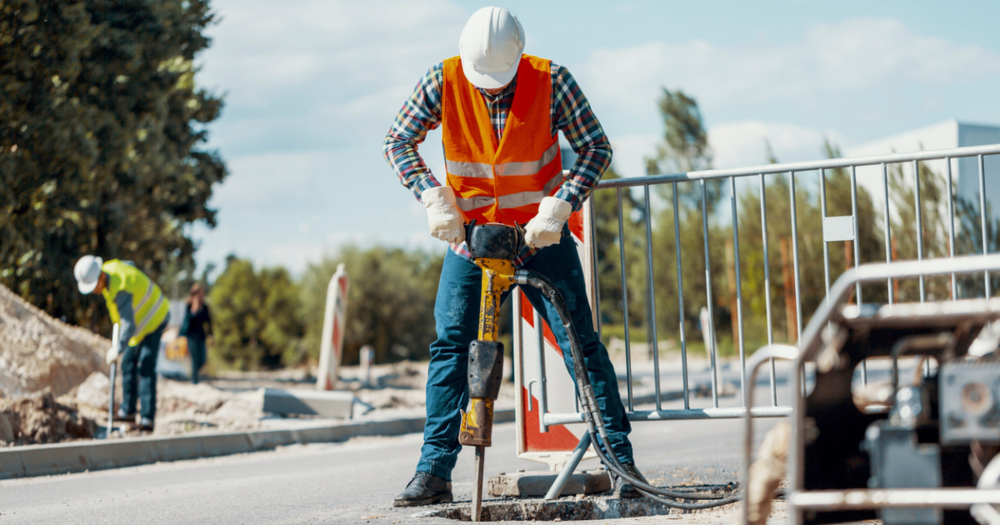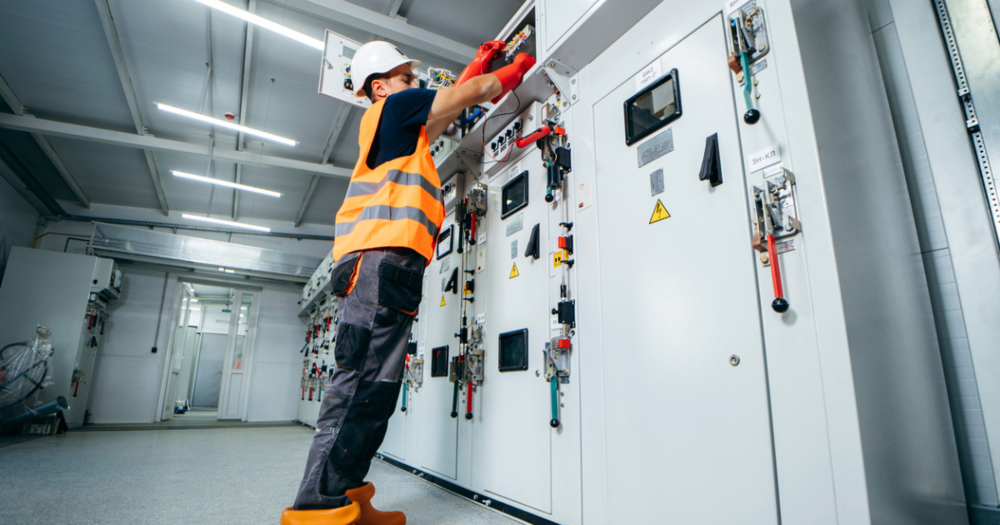Additionally, ANSI recognizes three types of high-visibility safety apparel: Type R, O, and P. Each type is designed for specific working environments and conditions, with distinct visibility requirements and features to address the unique risks associated with those environments.
Let’s break down each safety vest category to understand what they are and which vest is appropriate for your specific needs.
Class 1 Safety Vests
Description: Class 1 (also known as Class I) safety vests offer the minimum level of visibility among the three classes.
- They are designed for use in environments where traffic does not exceed 25 mph, and there is ample separation between workers and vehicles.
Suitable environments or jobs: These vests are ideal for low-traffic areas where workers’ attention is not on approaching traffic.
- Examples of occupations that benefit from Class 1 vests include parking lot attendants and warehouse workers, who require enhanced visibility but are not exposed to high-speed traffic.
Design and performance requirements:
- Amount of reflective material: Class 1 safety vests must have a minimum of 155 square inches of reflective tape/material and at least 217 square inches of background material. This reflective material is designed to outline the person's body, enhancing visibility to vehicle operators.
- Width of reflective material: The standard does not specify a minimum width for the reflective material on Class 1 vests as strictly as it does classes, but the material must be distributed to ensure visibility.
- Placement of reflective material: The reflective material should be placed around the middle of the vest and capable of encircling the entire body. Additionally, it may include vertical stripes on the shoulders to provide visibility from all directions (360 degrees), ensuring the wearer is visible from any angle, even if obstructed.
- Performance: The reflective material must meet specific criteria for visibility, ensuring that it effectively makes the wearer visible under all light conditions, including during the daytime and when illuminated by headlights in the dark.
Class 2 Safety Vests
Description: Class 2 safety vests (also referred to as Class II) provide moderate visibility for wearers.
- They’re suitable for areas near roadways where traffic exceeds 25 mph but does not exceed 50 mph.
- These vests have more reflective surface area than Class 1 vests, making them more visible in dimly lit conditions.
Suitable environments or jobs: This class is recommended for individuals working near roadways or in higher-traffic areas.
- These jobs could include construction workers, surveyors, school crossing guards, and personnel at high-volume parking or toll gates.
- The enhanced visibility is crucial for their safety in these potentially hazardous environments.
Design and performance requirements:
- Amount of reflective material: Class 2 safety vests must have at least 775 square inches of background material and 201 square inches of reflective material. This ensures the wearer is visible from 360 degrees (i.e., all sides).
- Width of reflective material: The reflective material used on the vests should be at least 1.375 inches wide. This width is essential to ensure visibility from a distance and in various light conditions.
- Placement of reflective material: The reflective material on Class 2 safety vests must be placed around the middle of the vest and over the shoulder. This placement ensures that the wearer is visible from all sides (including the back and front) and that the reflective material is seen at the body's highest and most visible points.
- Performance: The reflective material must meet performance criteria for visibility, ensuring that it is highly reflective and visible in daylight and under illumination by vehicle headlights in the dark.
Class 3 Safety Vests
Description: Class 3 safety vests (Class III) offer the highest level of visibility.
- They are designed for workers in the most dangerous environments, where traffic speeds exceed 50 mph, visibility conditions are poor, and workers need to be highly visible through a full range of body motions at a minimum of 1,280 feet (390 meters).
Suitable environments or jobs: The primary goal of a Class 3 safety vest is to make the wearer as visible as possible in low light conditions, against complex backgrounds, and in situations where the worker's attention may be diverted from approaching traffic hazards.
- Class 3 safety vests are crucial for workers with high task loads in dangerous environments and must focus on their work rather than oncoming traffic.
- They are essential for emergency responders, roadway construction workers, utility workers, survey crews, railway workers, and anyone working in environments where the risk of accidents is significantly higher due to traffic speed or conditions.
Design and performance requirements:
- Amount of reflective material: Class 3 safety vests require a minimum of 310 square inches of reflective material and 1,240 square inches of high-visibility background material. This ensures the highest level of visibility for the wearer from all angles, including in low-light conditions or at night.
- Width of reflective material: The reflective material should be at least 2 inches wide to maximize visibility. This width helps outline the person's body, enhancing recognition by drivers or machine operators.
- Placement of reflective material: The reflective material on Class 3 vests must cover the arms and/or legs and the torso. This design ensures visibility of the worker's entire body, enhancing the perception of human movement and making the wearer detectable from all directions at great distances.
- Performance: Class 3 vests often feature sleeves with reflective material to ensure visibility of the arms, which is critical for signaling and being seen from all angles. The design and arrangement of the reflective and background materials must support high visibility, not just in 360 degrees around the body but also vertically so that the wearer is visible from any viewpoint.

Safety Vests Types
Here's an overview of each type of safety vest:
Type R Safety Vests
Type R stands for "Roadway." These vests are designed for use in environments where there are roadway traffic hazards.
- Type R safety vests are intended for workers exposed to traffic from public access highway rights-of-way, temporary traffic control (TTC) zones, or work/construction areas.
- Type R vests can be either Class 2 or Class 3 in terms of visibility, depending on the specific requirements of the job site or the level of risk involved.
- Class 2 vests are for use in areas with slower traffic speeds or greater separation from traffic, while Class 3 vests are for high-speed traffic areas and poor visibility conditions.
Type O Safety Vests
Type O stands for "Off-Road." It’s intended for use in environments not exposed to traffic from public access highway rights-of-way or temporary traffic control (TTC) zones.
- This type of vest is designed for workers who are on sites where they are separated from vehicular traffic. These environments might include warehouses, recreational areas, or any place where vehicles or equipment move slower.
- Type O vests can be Class 1 in visibility, the lowest level. They provide the minimum high-visibility materials to differentiate the wearer from the non-complex work environment.
Type P Safety Vests
Type P stands for "Public Safety," and it’s specifically designed for emergency and incident responders and law enforcement personnel who require visibility and functionality from their high-visibility safety apparel.
- Type P vests often have features that accommodate tactical requirements, such as access to belt-mounted equipment, badges, and radio clips.
- Like Type R, Type P vests can be classified as Class 2 or Class 3 based on their visibility level.
- Their design and functionality are tailored to meet the needs of public safety workers, potentially including breakaway features for quick removal in dangerous situations.
Factors to Consider When Choosing a Safety Vest
When choosing a safety vest, it’s essential to ensure it meets
ANSI/ISEA 107-2010 standards for high-visibility safety apparel, which specify performance criteria for different classes of garments.
Additionally, use these guidelines to help select the correct class (or type) of safety vest:
- Visibility needs: Assess the level of visibility required based on the speed of surrounding traffic and lighting conditions. Higher speeds and lower light conditions necessitate higher-class vests.
- Work environment: Consider the nature of the work area – indoors, outdoors, near roadways, or in areas with high-speed traffic. The riskier the environment, the higher the class should be.
- Compliance requirements: Understand the safety regulations and standards for your industry or job role. Ensure the selected vest class meets or exceeds these requirements to maintain compliance and ensure your safety.
- Additional features: Depending on the work, features like pockets, breathability, and adjustability may influence the choice of vest class. While these features don't directly impact the class, they can affect the functionality and comfort of the vest in different environments.
Choosing Quality Safety Vests for You and Your Workers
When it comes to safety in high-risk environments, visibility is non-negotiable. However, it's equally important that safety vests offer comfort, ensuring that wearers are protected and can perform their tasks without hindrance.
Baseline Equipment recognizes this dual need and offers an extensive range of high-visibility clothing designed to meet the diverse requirements of your team.
Industrial ANSI Class II Vests
We offer a range of Class 2 safety vests, from the
Kishigo Black Series Flame Resistant Class II Mesh Vest to the SitePro 750 Class 2 Premium Surveyor's Vest.
Our Class 2 safety vests include a variety of features like:
- Breathability: Made with lightweight, breathable materials to ensure comfort even in warm climates.
- Accessibility: Equipped with pockets for radios, phones, and essential tools, ensuring everything you need is within reach.
- Durability: Reinforced stitching and durable fabric choices stand up to the rigors of the job site.
- Visibility: Bright colors with reflective tape ensure workers are seen in low-light conditions.
Explore Class II Vests at Baseline Equipment.
Industrial ANSI Class III Vests
We offer several Class 3 safety vest options for the highest-risk environments, like the
Dicke Safety Products Class 3 Lime Mesh Triple Trim Safety Vest.
Our Class 3 safety vest selection includes features like:
- Maximum visibility: Additional reflective material and brighter colors for visibility from greater distances.
- Full range of motion: Designed to be seen from any angle, ensuring safety in all directions.
- Breathable materials: High-quality fabrics provide comfort without compromising safety.
- Versatility: Suitable for a wide range of weather conditions and job types.
Discover Class III Vests at Baseline Equipment.
Women's Vests
Recognizing the need for vests that fit well and offer maximum protection, we also provide options specifically designed for women.
These vests ensure all team members can access safety gear that fits correctly and comfortably.
Check Out Women's Vests at Baseline Equipment.
Empowering Safety in the Workplace with the Right Gear
Remember that your choice is vital to personal and team safety when considering safety vest options. As with almost every safety situation, opting for a higher-class vest than the work zone's minimum requirements is always okay.


